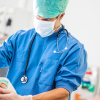Recent Posts
Most Popular
A Day in the Life of a CRNA: Insights & Realities

Summary
- A CRNA’s schedule can vary depending on several factors, but they can usually expect to perform certain daily tasks regularly.
- Pre- and post-surgical monitoring and addressing pain management needs are essential functions performed by CRNAs during shifts.
- Aside from clinical duties, CRNAs can expect to perform documentation, debriefing, patient follow up and other administrative tasks throughout their day.
Certified registered nurse anesthetists (CRNAs) are vital members of anesthesia teams who operate primarily within hospitals or surgical facilities. Outside of a hospital setting, CRNAs might practice in clinics, medical offices or government facilities. While they often collaborate closely with surgeons and anesthesiologists, they also operate independently, particularly in under-resourced environments. In rural hospitals, CRNAs may find themselves as the sole anesthesia practitioners. As practice environments can so widely vary, every day brings unique and fluctuating duties for CRNAs.
Throughout all the different institutions I’ve worked in, I’ve found that there are certain daily functions that are generally required in my role. However, I’ve also found that shifts can differ greatly depending on the patient population or the setting. One thing that is certain, though, is that I always expect to encounter situations in which I might need to make critical and often split-second decisions that can affect the health outcomes of my patients.
So, what does a typical day in the life of a CRNA look like? Read on for a brief overview, highlighting these key aspects of the role:
- Preoperative preparation and patient interaction
- Administering anesthesia and monitoring patients during surgery
- Providing post-operative care in the PACU
- Debriefing and administrative tasks
- Continuous learning

Beginning of shift, setting the day’s stage
Before the hustle and bustle of the hospital fully kicks in, a CRNA has already begun his/her day. The shift typically begins with an early arrival to review the day’s schedule, assess patient charts and collaborate with the care team involved in upcoming procedures. Some tasks include preparing drug pulls, evaluating plans of care and checking that all necessary equipment is in good working order to ensure a safe delivery of anesthesia. This pre-operative preparation is crucial for providing a smooth and safe surgical journey for each patient.
Welcoming patients
CRNAs are vital in alleviating anxieties and establishing a positive rapport with patients upon arrival. To foster trust, they explain their role, review anesthesia plans and make themselves available to answer questions. By providing reassuring and ongoing patient interaction before, during and after procedures, CRNAs are setting the foundation for a positive patient experience.
Search CRNA Jobs NowInside the operating room
During a surgical procedure, CRNAs orchestrate anesthesia care either independently or within a care team model with an anesthesiologist. Intra-operative duties include monitoring vital signs, administering anesthesia medications, documentation and adjusting the anesthetic plan as needed throughout the surgery. Additionally, CRNAs collaborate closely with surgeons and nurses, ensuring detailed and optimal care during the entire procedure.
Monitoring recovery
Following surgery, CRNAs often provide post-operative care to patients in the post-anesthesia care unit (PACU). They collaborate with the PACU team to monitor a patient’s recovery from anesthesia and to allow a smooth transition as they’re awakening from anesthesia, for those that aren’t already conscious. CRNAs also address any pain management needs and work closely with nurses to provide thorough post-operative instructions.
Debriefing
When necessary, a debriefing with the surgical team might be scheduled to allow for reflection on the procedures and identify opportunities for continuous improvement.
Administrative functions
Some CRNAs may also find time during the day to perform administrative tasks that support the department's overall functioning. These duties might include personnel management, budgeting, risk management and quality assurance. These services – while not clinical – directly influence the efficiency and quality of the services provided.
Follow-up care
A CRNA’s commitment to their patients’ recoveries and well-being carries on well after they leave the facility. CRNAs often follow up with patients in the days after surgery to assess their progress and address any lingering concerns.
Ending the shift, but not the journey
As the official workday ends, CRNAs must also dedicate time during or after shifts to ongoing education and research. As this role is continuing to grow and evolve, CRNAs must stay current with the latest advancements in anesthesia practices to remain knowledgeable and competitive in the field.
All shifts, whether in permanent or locum tenens roles, require equal parts clinical experience, adaptability and a driving commitment to patient care. At the end of the day, I should be able to look back and feel confident that I’ve provided my patients with a successful and comfortable surgical journey, from the moment they arrive at the facility, until discharge – and even beyond.
It's important to note that this is not an exhaustive list of CRNA duties, and the specific responsibilities of a CRNA’s schedule can vary depending on various factors, including the healthcare facility, practice setting and individual patient needs. A CRNA’s schedule and duties are also dependent on whether they work in a permanent role or as a locum tenens on assignment.
Regardless, CRNAs can expect to encounter unique challenges throughout their day, but the rewards that follow are plentiful, making it a fulfilling career for those who thrive in complex and fast-paced environments.
All information, discussions and opinions contained within this blog or otherwise on the website or any linked materials (“the “Blog Content”) is for general informational purposes only. All Blog Content is based on the author's opinions and experiences and is not necessarily representative of our opinions as an organization. It should not be considered as tax/financial advice, legal advice, compliance advice, health advice or other professional advice and does not constitute the practice of any medical, nursing or other professional healthcare advice, diagnosis or treatment or provision of legal services. You should seek professional assistance for any concerns or issues. If you or any other person has a medical concern, you should consult with your healthcare provider or seek other professional medical treatment immediately. While we strive to provide accurate and up-to-date information, we make no warranties or representations regarding the completeness, reliability, or accuracy of the Blog Content. Your use of the Blog Content is solely at your own risk and we will not be liable for any damages or losses arising from the use of, or reliance on, any Blog Content.





 Brant Langlinais
Brant Langlinais


Comments